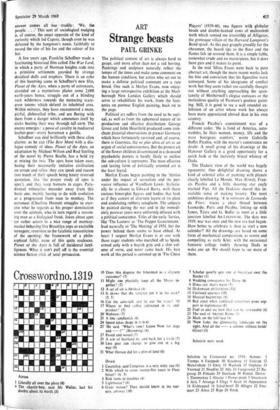Strange beasts
ART PAUL GRINKE
The political content of art is always hard to gauge, and more often than not a red herring. Paintings and sculpture naturally reflect the tempo of the times and make some comment on the human condition, but artists who set out to make a definite political comment are a rare breed. One such is Merlyn Evans, now enjoy- ing a large retrospective exhibition at the Marl- borough New London Gallery which should serve to rehabilitate his work, from the foot- notes on postwar English painting, back on to the page.
Political art suffers from the need to be topi- cal, as well as from the ephemeral nature of its production and effective distribution. George Grosz and John Heartfield produced some tren- chant pictorial observations in prewar Germany which have fortunately survived and, of course, there is Guernica, the ne plus ultra of art as an organ of social consciousness. But the protest art of the flower children disseminated in a thousand psychedelic posters is hardly likely to outlive the sub-culture it represents. The most effective and lasting form of politically oriented art is the least literal.
Merlyn Evans began painting in the 'thirties under the impact of surrealism and the per- vasive influence of Wyndham Lewis. Stylistic- ally he is closest to Edward Burra, with those curious bimorphic figures and bodies that look as if they consist of alternate layers of tin plate and undulating rubbery ectoplasm. The subjects he painted during the war and in the immedi- ately postwar years were uniformly infused with a political conscience. Titles of the early 'forties, like 'The Looters' or The Puppet Government,' lead naturally to 'The Meeting' of 1951, but the power behind them seems to have ebbed. At heart I suspect Merlyn Evans is at one with those eager students who marched off to Spain, armed only with a boyish grin and a .slim vol- ume of verse, and never came back. His best work of this period is summed up in 'The Chess
Players' (1939-40), two figures with globular heads and double-banked rows of malevolent
teeth which remind me irresistibly of Alligator, the grotesque villain of the Harvard Lampoon's Bond spoof. As this pair grapple greedily for the chessmen, the board tips to the floor and the flames lick up around them. It is a simple fable, somewhat crude and no masterpiece, but it does have guts and it makes its point.
In the mid 'fifties Evans went back to pure abstract art, though the more recent works lack the bite and conviction that his figurative work conveyed. Some of his ideograms of conflict work but they seem rather too carefully thought out without anything approaching the spon- taneity of Motherwell's elegiac canvases or the meticulous quality of Pasmore's postwar paint- ing. Still, it is good to see a well rounded ex- hibition of an artist whose work has always been more appreciated abroad than in his own country.
Francis Picabia's commitment was of a different order. 'He is fond of America, auto- mobiles, he likes women, money, life and the most bourgeois comfort,' wrote Gabrielle Buffet Picabia, with the master's connivance no doubt. A small group of his drawings at the Hanover Gallery is a good opportunity for a quick look at the incisively brutal whimsy of Dada.
The Dadaist view of the world was hugely egocentric. One delightful drawing shows a kind of celestial atlas of painting with planets clearly labelled Le Monde, Max (Ernst), Fran- cis -Picabia and a little shooting star coyly marked Pipi. All the Dadaists shared this in- violable sense of making history. The most ambitious drawing, 'A la memoire de Leonard'? da Vinci,' traces a clear thread between Leonardo, Paris and Picabia, linking up with Janco, Tzara and G. Buffet to meet at a little junction labelled An.I.PEINTURE. The date WO 1919, war was over and the new era had begun. How better to celebrate it than to start a new calendar? All the drawings are based on some form of mechanical composition, as severe and compelling as early Klee. with the occasional fantastic collage rudely shouting Dada to wake one up. We should hope to see more of them.






































 Previous page
Previous page